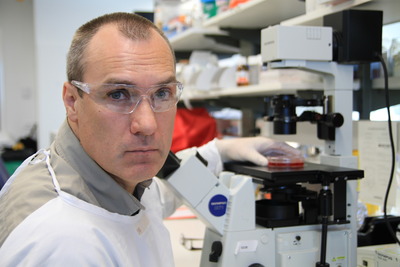Identifying unsafe stem cells
Human induced pluripotent stem (iPS) cells have the potential to generate healthy cells and tissues for the study and medical treatment of a large number of diseases, but until recently there had been no assay to identify unsafe lines of the cells. Now, CSIRO scientists have developed the first safety test for iPS cells.
The research, which has been published in the international journal Stem Cells, is an important step towards improving the quality of iPS cells and identifying unwanted cells that can form tumours. The test also determines how stable iPS cells are when grown in the lab.
Stem cell expert Dr Andrew Laslett and his team have worked on the project for the past five years, comparing different types of iPS cells with human embryonic stem cells. iPS cells are now the most commonly used pluripotent stem cell type for research and are beginning to move towards potential clinical applications, according to Dr Laslett.
“The test we have developed allows us to easily identify unsafe iPS cells. Ensuring the safety of these cell lines is paramount and we hope this test will become a routine screen as part of developing safe and effective iPS-based cell therapies,” said Dr Laslett.


The team’s test method has shown that certain lines of iPS cells, created with certain techniques, carry more risk. The standard technique relies on viruses to permanently change the DNA of a cell; some iPS cell lines made this way are able to re-form stem cells, which is “a real danger”.
“We’ve shown that when we put these cells into animals that they are capable of forming tumours known as teratomas,” explained Dr Laslett.
Cells made using methods which do not alter cell DNA do not form tumours.
“So what this test shows is that these cell lines made using viruses are both unstable and unsafe for human use,” said Dr Laslett.
Dr Laslett hopes the study and test method will help to raise the awareness and importance of stem cell safety and lead to improvements in quality control globally.
“What we hope the publication of this test will do is to show people that not all stem cells are safe; we need to be really careful when we're thinking about putting cells made from stem cells into people,” he said.
“It is widely accepted that iPS cells made using viruses should not be used for human treatment, but they can also be used in research to understand diseases and identify new drugs. Having the assurance of safe and stable cells in all situations should be a priority.”
The test uses laser technology to identify proteins found on the surface of the cells. Based on the presence or absence of specific proteins, the cells are then separated and monitored. Unsafe stem cell lines are identified because they form recognisable clusters of cells and the safe ones don’t. This test could also be applied to assess the safety of the recently announced somatic cell nuclear transfer human embryonic stem cells.
Professor Martin Pera, Program Leader of Stem Cells Australia, said, “Although cell transplantation therapies based on iPS cells are being fast tracked for testing in humans, there is still much debate in the scientific community over the potential hazards of this new technology.
“This important study provides a simple and powerful technique for assessing how safe stem cell lines are for use in patients.”
Blood test could be used to diagnose Parkinson's earlier
Researchers have developed a new method that requires only a blood draw, offering a non-invasive...
Cord blood test could predict a baby's risk of type 2 diabetes
By analysing the DNA in cord blood from babies born to mothers with gestational diabetes,...
DNA analysis device built with a basic 3D printer
The Do-It-Yourself Nucleic Acid Fluorometer, or DIYNAFLUOR, is a portable device that measures...



